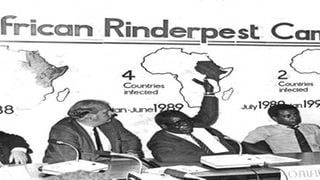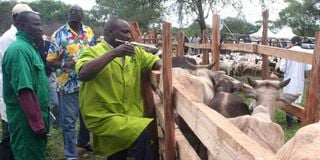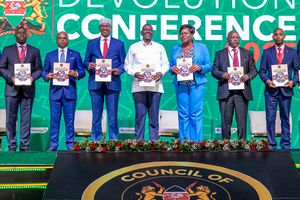
Dr Walter Masiga of the Inter-African Bureau of Animal Resources shows the technical staff of the Pan African Rinderpest Campaign the part of Kenya plagued by rinderpest in 1989 before its eradication. File | Nation Media Group
| File | Nation Media GroupNews
Premium
How Kenya developed vaccine that eliminated rinderpest
What you need to know:
- From 1889 and 1897, disease swept across Africa killing 90per cent of all cattleThe Muguga vaccine.
- The Muguga vaccine has for many years remained the vaccine of choice in the eradication of rinderpest.
Since countries are singing praises about their Covid-19 vaccines, let me remind Kenyans that our own Muguga veterinary research station is credited globally for developing a vaccine that saved the world’s livestock from rinderpest. Yes! We have been there, too.
But there is another story behind that discovery. But first, the good news: Some 10 years ago, the Food and Agriculture Organization (FAO) declared rinderpest eradicated. It was a victory that started, partly, in our own research station and a lesson to those countries playing politics with Covid-19 vaccines.
And now, the Muguga story; and it goes that when World War II broke out, there was fear that Germany, Japan and Italy might use rinderpest as a biological weapon to destroy herds in the US – the biggest meat-eating nation in the world.
For some years, both US and UK had been trying to develop a biological weapon from rinderpest and US Congress records confirm that the US War Department had established a laboratory - “for the purpose of experimentation of rinderpest” - at Grosse Ile, the Canadian island at the mouth of St Lawrence River and which was previously, from 1832 to 1937, set aside as a quarantine station for newly arrived immigrants.
By then, Kenya had in 1911 isolated a highly lethal strain of rinderpest at the newly-opened veterinary pathology laboratory at the Government Farm in Kabete and where research was also being carried out on East Coast Fever.
Lethal strain of rinderpest
Thus, by possessing the most virulent strain of rinderpest, and which had been kept safely and alive in the Muguga laboratory, Kenya was sitting on two things: a biological warfare agent or the answer to rinderpest control.
Scientists had designated this strain as “Kabete O”. It is still one of the oldest laboratory strains of any virus in existence.
Back to the Canadian Island at Grosse Ile, a secret project to develop biological weapons had commenced as the World War II progressed. The man behind this research station and development of bacteriological weapons – but which were never used - was Canadian bacteriologist Prof E.G.D Murray, who once remarked that “when an international crisis arises, usually because of obstinate politics, the scientist must put his all into securing victory.” He was also working with American scientists.
What we now know is that a vaccine was developed there. But we only know it, first, from a letter dated June 8, 1945 and from Oliver Stanley, the UK Secretary of State for the Colonies, when he urged the Kenyan governor, Sir Phillip Mitchell, to arrange tests of the new vaccine as a matter of “great importance.” The tests were to be done in Muguga.
On the second top secret telegram, sent the same day, Stanley explained that there was fear that Japan might try to infect North America with rinderpest and there was urgency to test whether the vaccine would work. By then, no cases of rinderpest had been found in the US and it was worried that its dairy industry could be wiped by Japan.
Biological warfare project
We also know the link between the Muguga experiments and those at Gross Ile from a 1948 US Congress Hansard report which highlights the fears that led to the establishment of that Canadian research station: “We were afraid the Japanese were going to scatter the (rinderpest) germs all over this country, but we were ready for them. We produced 5 million doses and never had to use any of them. That was the first time a permanent-immunity vaccine for rinderpest had ever been produced and it took less than a year to do it,” said George Gillie, the Indiana Congressman.
But had the US developed a permanent-immunity vaccine? Certainly, no – for that would come later.
Again, we now know that the US fear emanated from the activities of Unit 731, a covert biological weapon project of the Japanese army. It was said that Unit 731 was planning to drop epidemic-creating weapons after it finished conducting biological and chemical weapons tests on prisoners and captured prisoners of wars. It is now estimated that more than 10,000 prisoners died as a result of experimental infection during this Japanese programme between 1932 and 1945.

A veterinary officer vaccinates cattle at Kinna livestock market in Garbatulla during a livestock vaccination exercise to mark the eradication of rinderpest.
Here, they would deliberately inject men, women and children with lethal germs and then dissect them to see how the viruses transformed the organs. At least 3,000 of the victims were prisoners of war who were injected with experimental viruses.
You might need to read further on why this matter of biological experimentation on humans never surfaced at the Tokyo War Crime trials. But to cut a long story short, the US investigator, Norbert Fell, played a key role in concealing information about the biological warfare experiments in exchange for the reports from Shiro Ishii, the commander of Unit 731. The US needed those scientific reports and exchanged them for immunity.
But elsewhere, the desire to end rinderpest was of concern even after the end of the war. While rinderpest was not harmful to human beings, it was lethal to animals and had stopped the expansion of dairy industry in new colonies. Introduced to Africa in 1889, after infected cattle were shipped from India, the virus caused, perhaps, the most catastrophic natural disaster ever to affect livestock in the continent.
Rinderpest vaccine
Between 1889 and 1897, rinderpest swept across east and southern Africa killing 90 per cent of all cattle. That was akin to the 1700 devastation in Europe where it killed millions of cattle and led to the establishment of the first veterinary schools.
Before a vaccine was found, the best that was done was to quarantine the sick animals or slaughter them to save the herd.
When the story of the Rinderpest vaccine is told, the work of Walter Plowright in Muguga is usually silently celebrated. But he is regarded as the saviour of the dairy industry. The Muguga vaccine has for many years remained the vaccine of choice in the eradication of rinderpest and for mass campaigns, albeit with a few modifications.
So what did the Kabete laboratory scientist do? After he arrived in Muguga in 1956, Dr Plowright and his colleague R. D. Ferris began studying the rinderpest virus. While his fellow scientists had tried to develop a weakened version of the rinderpest virus to serve as a vaccine – the same way Edward Jenner had developed the smallpox vaccine from a weakened cowpox virus – Dr Plowright went for a new technique.
At the Kabete laboratory, he started developing a vaccine by picking the 1911 “Old Kabete” strain and growing it in some glass tubes and “in primary calf kidney cells”. He would then harvest these cells and reseed them to create new ones – until he got a weakened version of the virus after eight years of experiments. Scientists agree that this weakened form of the virus, for the first time, “provoked immunity to rinderpest but did not produce disease. The weakened virus was inexpensive to produce and could be grown in large quantities.”
Muguga technique
Scientists called it “tissue culture rinderpest vaccine” but before its success, there had been attempts to make a vaccine at an Indian laboratory in 1920s but animals with weakened immune system still got it.
The Muguga technique and vaccine swiftly replaced all the other vaccines and inspired many other scientists to start similar research on viral diseases such as the African swine fever - and with great success.
The only drawback to the Plowright tissue culture vaccine (PTCV) was that it required cold storage and had to be used within 30 minutes of reconstitution to ensure potency. While this led to failure of rinderpest control in regions with hot climate, Tufts University scientists then made improvements to the Muguga vaccine by developing what is known as a thermovax.
As he was eulogised when he died in 2010, Plowright had spent his time in the field testing his products on wildebeests. One of his colleagues, Frank Dobson, was quoted by The Independent saying: “Surely, no one is going to go out there to wrestle with wild buffalo [wildebeest], and inoculate a quarter of a million of them – but Walter Plowright did!”
And with that experiment in Muguga, a Kenyan research station, entered into the world map by helping to develop a vaccine. I hope the legacy continues.
[email protected] @johnkamau1





